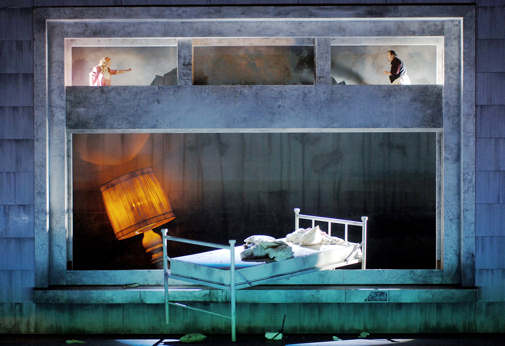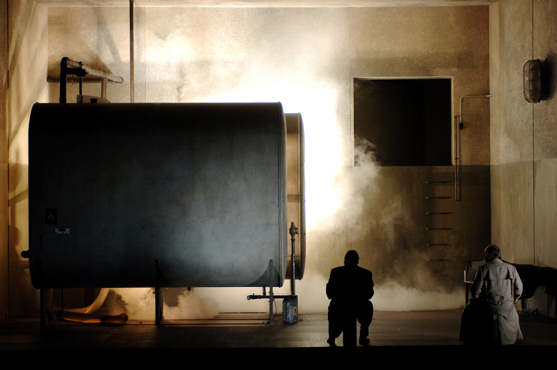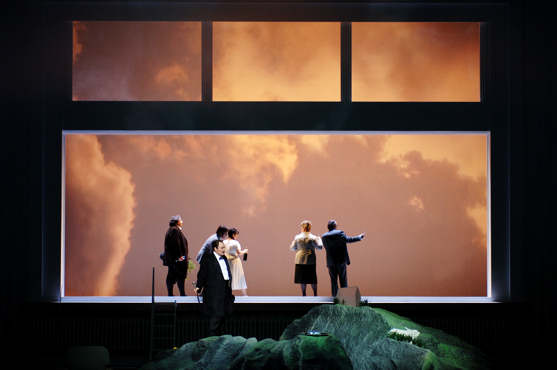Other Links
Editorial Board
- Editor - Bill Kenny
- London Editor-Melanie Eskenazi
- Founder - Len Mullenger
Google Site Search
SEEN
AND HEARD INTERNATIONAL OPERA REVIEW
Wagner, Das
Rheingold: (New
production) Soloists, Hamburg Philharmonic Orchestra.
Conductor: Simone Young. Staatsoper Hamburg. 16.3.2008 (JPr)
My heart sinks as soon as I see, as I did here, an essay by Udo Bermbach
in a German Ring programme. Mark Berry writes in his book
‘Treacherous Bonds and Laughing Fire: Politics and Religion in
Wagner’s Ring’ how the political scientist Bermbach’s approach ‘seriously misrepresents not only Wagner’s
compositional method but also his intellectual method. It also
sidelines inconvenient aspects of the drama that fails to “fit”
whichever interpretation is selected … Interpretation will always
court controversy, but Bermbach – and many others – simply ignore
large chunks of the drama which do not suit their case, or
alternatively declare irrelevant without deigning to explain why.’
Production by Claus Guth, Sets and Costumes by Christian
Schmidt.

At Bayreuth, the German director Claus Guth’s Der fliegende
Holländer was set entirely in Senta’s house and there were
strong hints that Senta was abused by her father, Daland:
emotionally scarred, she dreamed up a fantasy lover. The Dutchman
was portrayed as a version of Senta’s father and she longed to be
swept away from her stifling home surroundings. There was not a
drop of water to be seen anywhere. Based on my experience of that
production, I was not surprised to find that Guth’s Das
Rheingold (in sets and costumes by Christian Schmidt, as at
Bayreuth) played even faster and looser with Wagner’s intentions.
On this first night of a developing Ring project which will
not be completed until October 2010, there were many positives
that helped dispense with too many reflections as to what it all
was about - assuming that it had little to do with Wagner’s text.
As Simone Young, music director and general manager of Hamburg
State Opera has said ‘For any opera house, the Ring is a
“mission statement”, a declaration in the power of art. It is a
great challenge and a privilege to present this musical monument
with my team.’ The last new staging of Das Rheingold there
was 16 years ago and it had 24 outings but the opera (or
Vorabend) has not been seen in Hamburg for nearly ten years.
Perhaps the only heavily underscored symbolism of the whole evening was right at the
beginning when the curtains opened to reveal a large (river?) bed
on which the three Rhine daughters cavorted in their nightclothes.
The bed seemed to be hanging out of a window and there is a large
lamp standard stage-right and with a walkway above. This part of
the staging seemed to suggest a doll’s house or similar but then
when we first see the ‘gods’ they seem to be in attic with Wotan, a
German film director, and his special effects set, lighting and
camera. Costumes are vaguely early twentieth century. When we
descend to Nibelheim we are in a boiler room. So nothing is very
clear yet. The ‘giants’ seem beer-swigging, smoking mafia-types in
shiny-suits and gold chains and have probably financed Wotan’s
film-project and now want their payment. Erda on her appearance
seems to the star of the film in dark glasses and scarf. A second
moment of directorial heavy handedness has her run some ‘earth’ (Erde) through her
fingers and then she waters a small tree that undoubtedly will
grow (or not?) and feature in Die Walküre.

I will not
give a ‘blow by blow’ account of what I have seen in other
productions before but there was quite a lot including Loge, with slick
black-hair and pencil moustache, as a magician. Here (yet again) he is
complete with top hat, cane and bag of tricks including hypnotism,
cards, producing scarves, roses, flames and lightning flashes. I
have been told there is an intellectual argument for these
borrowings from previous productions but it has never actually
been explained to me what this is. As the ‘story’ unfolds, Alberich
is in a chemical suit dealing with the weeds outside the ‘window’
and as he pursues the Rhine Maidens, we enter a dubious world of
forbidden love which includes some over-familiar fetishism towards Wellgunde’s single red sparkly shoe. Alberich curses love
perversely with a sheet of twinkling silver, rather than gold,
lights. In Nibelheim he is first seen in his lab-coat, the change
to the ‘Reisen-Wurm’ is botched and relies on some clanking and
steam. Later his ‘Hort’ and ‘helles Gold’ are suitcases of paper
money and Freia is given a wedding veil to which money is pinned
to conceal her, a tradition of the wedding ceremony for many
cultures throughout the world. It all ends in a champagne
reception before the ‘gods’ clamber up a ladder to enter Valhalla.
Loge is left literally with (Fasolt’s) blood on his hands and his
magic seems to be deserting him as he struggles to bring the
curtains to a close.
There was
much deserved praise for the Australian Simone Young, her
near-faultless orchestra and singers. She has conducted Ring
cycles previously in Berlin and Vienna and her experience showed.
In the
twenty-first century there are so many great stories to be told
which current stage directors are simply avoiding. The abuse of science
and religious fundamentalism are just two of them that Wagner’s
Ring can be suited for but it seems there is a lack of courage.
Anyway it is too early to damn Guth completely although many of the booers in
the audience seem already to have made up
their minds. I would however, like to see much closer attention
given to what the music is trying to say, particularly at big
moments such as when Alberich’s hands are untied or when Wotan
imposes himself between the ‘giants’ and Donner singing about his
spear: here it was standing impotently at the back of the
stage. Also, towards the end, as we hear the Sword motif from
Die Walküre Wotan clutches the tiny knife that Fafner used to
kill Fasolt, an idea which also did the music, and Wagner,
no justice. But
there is still a long way to go.

Apart from one, everyone in the cast was singing their roles for the
first time. For someone who worries about the future of Wagner
singing, the fact that this Rheingold could be cast mostly from
‘home-grown’ talent at the Hamburg State Opera was a tremendous
achievement. We have a wonderfully potent new Alberich in Wolfgang
Koch, a fine (but almost too lyrical) Mime from Jürgen Sacher, a
sparky Woglinde in Ha Young Lee. There were also secure and strongly characterized
‘giants’ from Tigran Matirossian (Fasolt) and Alexander Tsymbalyuk
(Fafner), Katja Pieweck as a stern, nagging, Fricka and finally
there was Deborah Humble’s imposing Erda.
Hellen Kwon’s rather more matronly Freia was a bit of
disappointment and Peter Galliard’s Loge will benefit from more
performances as at the moment he lacks the natural insouciance of
Graham Clark or Kim Begley - who had the ability to sing well and
perform magic at the same time, a difficult feat at the best of
times. Jan Buchwald’s Donner was (as often these days) effete and
unheroic and although he sang well, his bulk did not help him when
he was made to clamber up onto the set within a set for his ‘Heda! Heda! Hedo!’. Nevertheless,
I would be happy to hear these and all the rest of the cast again and
my many pronouncements about the dearth of Wagner singers were
made to seem rather
foolish in this context.
I
leave part of my final comments to Falk Struckmann’s Wotan, a role
he has performed before. His character was asked to go from weary
befuddlement to greater authority and a desire for power and
he portrayed the transitions excellently. There were many interesting psychological
nuances revealed in his voice at the start, but he achieved his full
imposing stature as the evening went on. After his recent
and excellent Amfortas at Covent Garden. his Wotan was splendidly acted
and penetratingly sung. I look forward to seeing more of this
singer and his character’s journey in what appears to be an
important new Ring cycle. More familiar names are coming
will appear in the later operas which will ensure, I hope, that it
this cycle will l continue to be memorably sung as well as
conducted superbly.
Jim Pritchard
Pictures ©
Monika Rittershaus
Back
to Top
Cumulative Index Page
